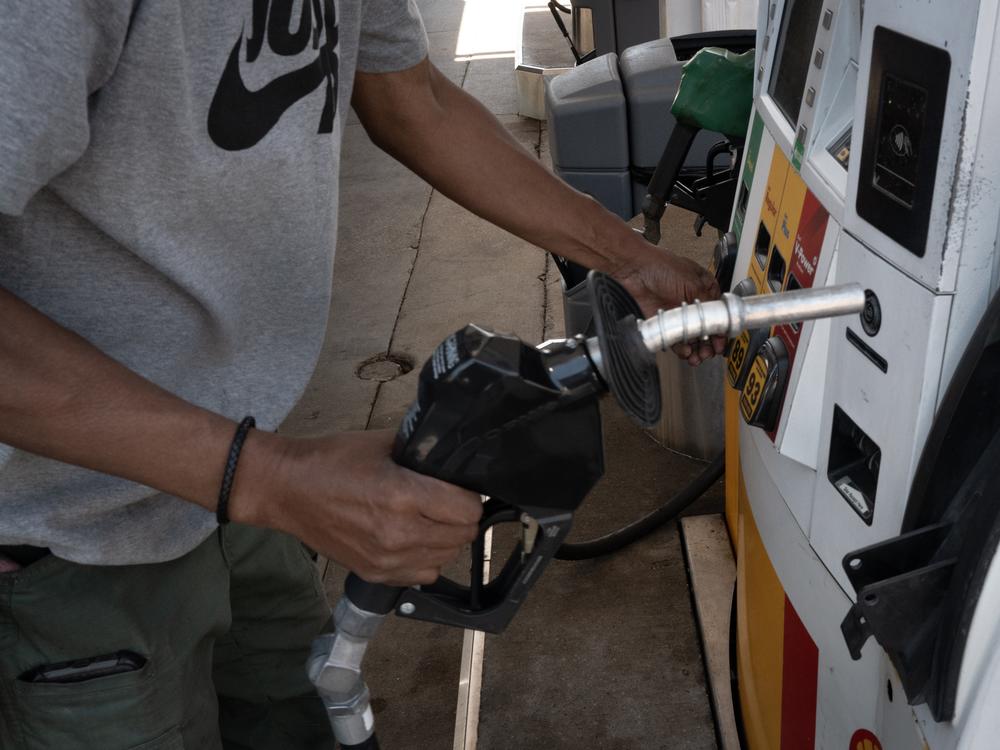Section Branding
Header Content
Gas prices are down. We could be headed for lows not seen since 2021
Primary Content
If you’re planning to squeeze in one last summer road trip over the coming Labor Day weekend, it won’t cost as much to fill up your tank compared to a few months ago.
The national average for a gallon of regular has fallen more than 20 cents since May and is now at $3.38 — about 47 cents lower than this time a year ago. Experts say the trend is likely to continue in the coming months, possibly leading to $3-a-gallon gasoline for the first time since 2021.
According to AAA, as of Thursday, the price per gallon for regular gasoline ranged from $4.59 in California, where state gas tax is the highest in the nation, to $2.93 in Mississippi, which has one of the lowest tax rates on fuel.
“For every Mississippi, you have a California to balance it out,” says Andrew Gross, a spokesperson for AAA.
"The late-season wild card is always hurricanes"
A year ago, excessive heat forced Texas refineries to curtail operations, and Hurricane Idalia temporarily shut down oil production in the Gulf of Mexico, which contributed to higher prices. Despite record-breaking heat waves across the country this summer, Texas and Louisiana, where the majority of U.S. refineries are located, haven’t been hit as hard.
“The late-season wild card is always hurricanes,” says Patrick De Haan, head of petroleum analysis at GasBuddy. “If a hurricane makes landfall in a refining area, it can really disrupt things.”
Forecasters have warned of a particularly active hurricane season this year, but things have been quieter than expected — so far. Hurricane Beryl did considerable damage in parts of the Caribbean and caused some disruptions to U.S. refinery operations, but things got back to normal pretty quickly.
Even so, energy analyst Stephen Schork, who is principal and co-founder of The Schork Group, cautions that we are entering peak hurricane season, which falls between mid-August and late October. In 2005, the double wallop of Hurricane Katrina at the end of August, followed by Hurricane Rita nearly a month later, “completely disrupted the market and sent prices extremely higher,” he says.
Despite the devastating effects of Katrina and Rita on oil supplies, those storms were seen as outliers. Typically, late-season storms have less impact on fuel prices, according to Tom Kloza, the global head of energy analysis for the Oil Price Information Service (OPIS). That’s because every year, around August, the industry transitions from a summer blend to a winter blend of gasoline. The winter blend, which evaporates at lower temperatures, is less expensive to produce. And that switch occurs just as the summer driving season is waning.
“The further we get into hurricane season without any major storms making landfall, the better for consumers,” De Haan says.
Global events, EVs and an aging U.S. population affect prices
But other factors are also influencing the current downward trend in gas prices.
Iran, which produces 3 million to 4 million barrels a day, continues to aid its Hamas, Hezbollah and Houthi allies arrayed against Israel amid the ongoing Gaza conflict, but so far that hasn’t affected Tehran’s oil production. “If Iran gets more heavily involved, that could be a problem. … But if things stay relatively contained there, it shouldn’t have much impact on gas prices,” the AAA’s Gross says.
Meanwhile, China’s demand for oil remains relatively low due to its flagging economy. OPEC+ is expected to curtail cuts in production starting in October. And the U.S. is pumping record amounts of petroleum.
“We’ve never produced more oil than we’re producing now,” Gross says. That record production comes as U.S. demand has tapered — from 9.8 million barrels of gasoline per day in recent years to barely 9 million per day now, Gross says.
Kloza points to several factors to explain the change: Remote work means fewer commuters. There are an estimated 3.3 million electric vehicles on U.S. roads, more than twice as many as in 2021. More EVs have helped keep demand for gasoline in check, although Kloza notes that the effect is relatively modest, with every million EVs sold reducing demand by about 22,000 barrels a day. And Kloza also notes the gradually aging U.S. population — older Americans, he says, “tend to drive a lot less.”
Barring unforeseen shocks, it all points to the likelihood of lower fuel prices for some time to come. GasBuddy’s De Haan says pump prices could crack the $3-a-gallon level before Thanksgiving and remain low into next year.
Of course, this comes as Americans prepare to vote in the general election. U.S. presidents have very little to do with gas prices, but that has rarely stopped them or their opponents from trying to score political points off the issue.
Kloza, from OPIS, expects we will see that again. “Whoever wins this election in November is probably going to take credit for cheap gas prices that you're going to see at the beginning of 2025,” he says.

